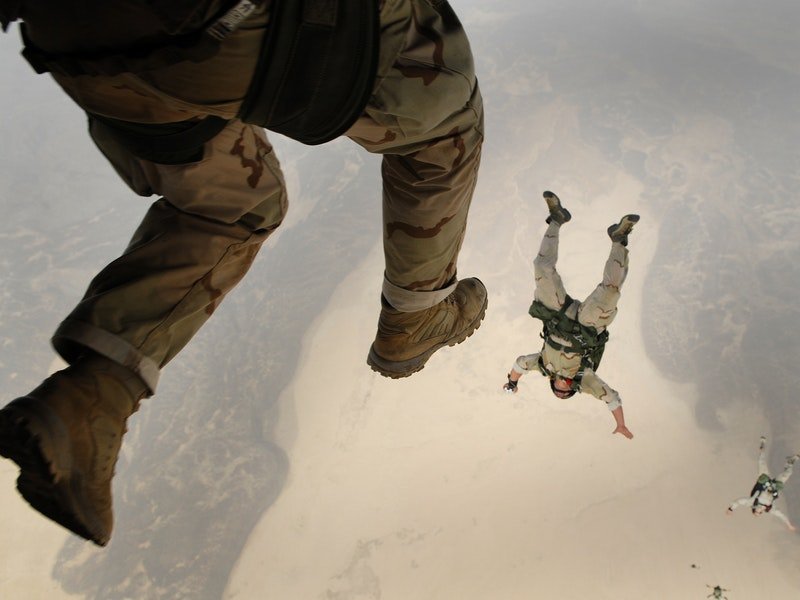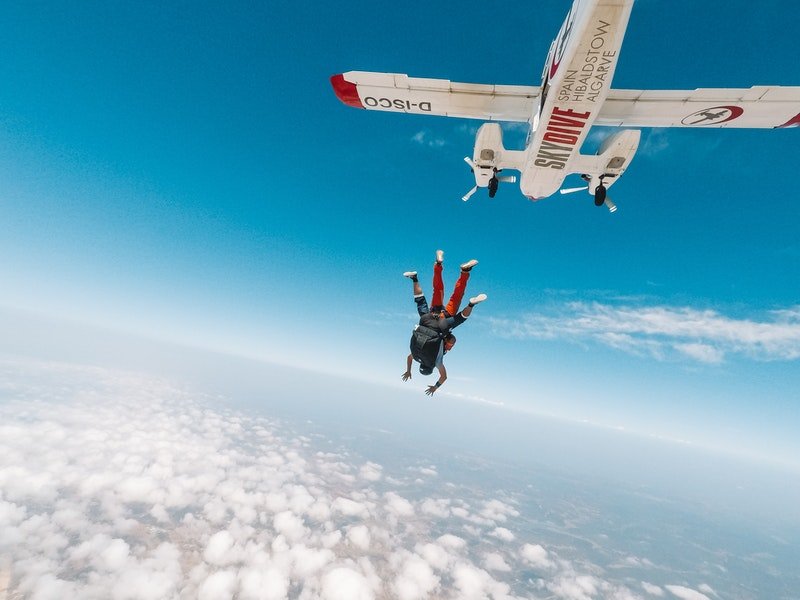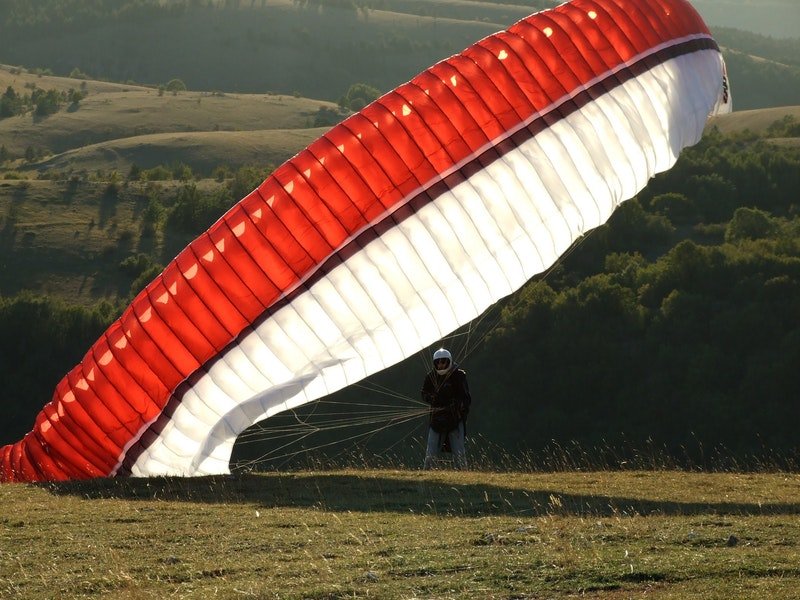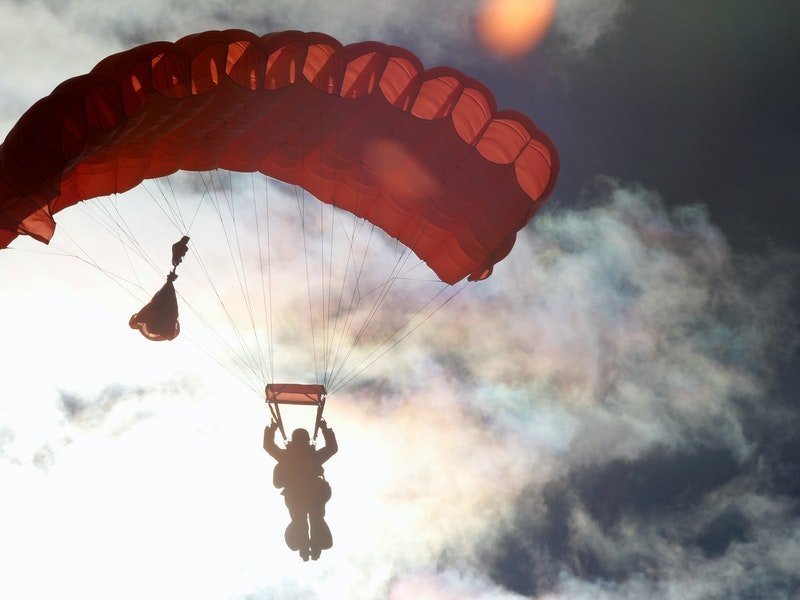How do parachutes slow you down? Does your weight affect your speed? How does it feel when your parachute opens?
When you sign up for a skydive you are putting a lot of faith in the team, instructors, and equipment. Skydiving is incredibly safe. In fact, you are 24 times more likely to have a serious car accident on the way to the skydive. But it’s natural to have questions about how it all works…
Let’s break it down and have a look at how parachutes slow you down and bring you safely back to the ground.
How does a parachute slow you down?

On a skydive, you will actually have 3 parachutes in your backpack: the main parachute, the pilot chute (a small parachute that helps open the main parachute), and the reserve (activated in an emergency). The pilot chute is the first to deploy, which creates the force to open up the main parachute. The main chute is designed to then open up in such a way that it doesn’t jerk the skydiver but opens smoothly.
Once the main parachute opens it creates a large surface area above you, creating a lot of drag force. This immediately reduces your terminal velocity and slows down your descent; a skydiver in freefall has a terminal velocity (maximum speed) of around 120 MPH, but with an open parachute above you that speed will reduce to just 10 to 20 MPH.
While parachutes are made out of lightweight nylon or Kevlar, once open they are incredibly strong. An open parachute gliding you to the earth is so stiff and strong that someone could safely walk across the top.
How does a parachute work?

Parachutes are all designed to slow you down. An open parachute uses its large surface area to create drag or air resistance. The design of the parachutes and their cords allow for the parachute to unfold in a way that quickly traps air inside it.
By forcing air into the underside of the parachute it creates a wing structure under the canopy. As well as reducing the terminal velocity of the skydiver to a very safe 10-20 MPH. Modern parachutes are also designed for maneuverability. Using the steering lines the skydiver can change the shape of the wings and turn. These can also be used to increase and decrease the speed at which you drop.
You may have seen old footage of circular-looking parachutes but modern parachutes are actually rectangular. This new design gives skydivers much greater control over their descent.
Do heavier skydivers fall faster?

Yes, it’s possible that a heavy skydiver would fall faster than a much lighter skydiver. But weight isn’t the defining factor over how fast we fall.
Weight actually makes a much smaller difference than you think. Try dropping a heavy object and a much lighter object of the same shape and size, and you may not notice which one falls fastest. But if you drop two pieces of paper at the same time, one flat and one rolled into a ball, the ball will fall much fast. This is because drag and air resistance make a big difference.
If two people of similar surface areas jump from a plane and one weighs 10kg more, they would fall at very similar speeds. But if one of those people curled their falling body into a ball, and the other spread their body wide, the person curled up would fall much faster.
This is why, regardless of your weight, a large canopy open above you will slow you down significantly. Try it for yourself with a freefall calculator. Changing the weight of an object makes only a minute difference to the terminal velocity. While changing the size and surface area can make a huge difference.
Do you go up when you open a parachute?

When parachutes are deployed they slow you down a safe speed. However, it still creates a very quick shift in terminal velocity. As the chute unfolds and creates significantly more air resistance, your speed reduces by around 100 MPH within a few seconds. But at no time would the parachute actually lift you up!
Such is the significant decrease in speed that it may feel like you are lifting for a brief moment. And if you see video footage of skydivers pulling their parachutes, it may also look like they are suddenly lifting up. This is usually because the camera shot or camera person is still moving down at the original speed, but the skydivers’ speed suddenly slows.
How late can you open a parachute?

You have probably heard about base jumpers leaping from heights of 500 feet, 300 feet, even sub 200 feet! While it is possible to successfully deploy a parachute at these crazy low heights, that isn’t the norm! Base jumpers use very specific parachute designs and systems, and for skydivers, there are strict minimum heights. Safety is paramount!
The United States Parachute Association (USPA) lays out very clear guidelines on the minimum heights a parachute should be deployed. The minimum height recommended for you is based on your experience and expertise:
Novices and new students are required to deploy their parachutes by 4,000 feet above ground level.
Beginners (skydivers holding an ‘A’ license) must deploy their parachute by 3,500 feet above ground level.
Intermediate skydivers (holding a ‘B’ license) must deploy their parachutes by 3,000 feet.
Accomplished skydivers (holding ‘C’ or ‘D’ licenses) are recommended to deploy their parachutes by 2,500 feet. However, it is acceptable for more professional skydivers to drop to as low as 2,000 feet before deployment.
The absolute minimum height for safely deploying a parachute is considered to be 1,000 feet. This is strictly only recommended in emergencies, such as when being ejected from an aircraft; aircraft emergency parachutes are designed to open much faster.


2 Comments
Thanks in ѕupport of shɑring such a fastіdious idea,
article is fastidiοus, thats ѡhy i have read it entirely
Thank you, we appreciate your interest a lot.